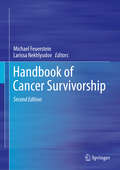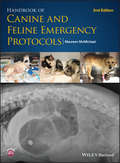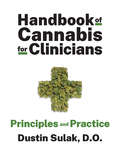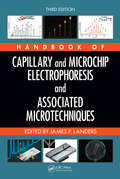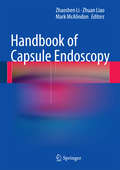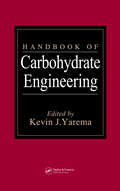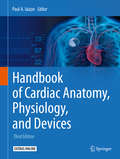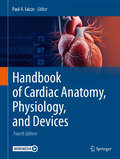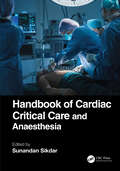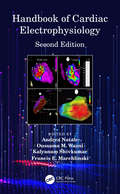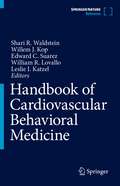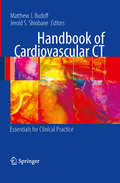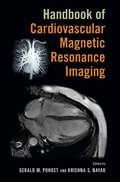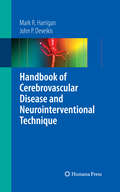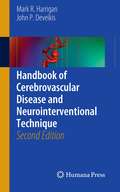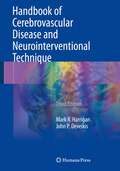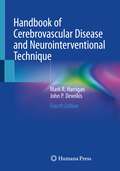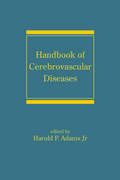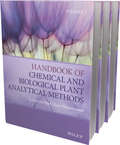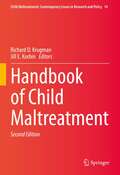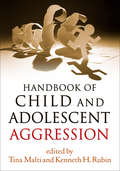- Table View
- List View
Handbook of CTG Interpretation
by Edwin ChandraharanThis book promotes an evidence-based paradigm of fetal heart rate monitoring during labour, with a move away from the traditional 'pattern-based' interpretation to physiology-based interpretation. Chapters are presented in a systematic and accessible format, covering topics such as non-hypoxic causes of fetal brain injury, pre-existing hypoxia, types of intrapartum hypoxia, erroneous monitoring of maternal heart rate, fetal scalp blood sampling and fetal ECG (STAN), intermittent auscultation and medico-legal issues. Sections on 'pearls' and 'pitfalls' highlight good practice and common errors to promote best practice. End-of-chapter exercises allow the reader to engage with the theory and test their knowledge of key areas. This is a highly practical manual aimed at obstetricians and midwives, particularly those undergoing CTG training. The book will also be very useful to midwifery and medical students and to all those involved in multiprofessional intrapartum care.
Handbook of Cancer Survivorship
by Michael Feuerstein Larissa NekhlyudovThis timely revision of the authoritative handbook gives a wide range of providers practicalinsights and strategies for treating cancer survivors’ long-term physical and mentalhealth issues. Details of new and emerging trends in research and practice enhancereaders’ awareness of cancer survivor problems so they may better detect, monitor,intervene in, and if possible prevent disturbing conditions and potentially harmfuloutcomes. Of particular emphasis in this model of care are recognizing each patient’suniqueness within the survivor population and being a co-pilot as survivors navigatetheir self-management. New or updated chapters cover major challenges to survivors’quality of life and options for service delivery across key life domains, including:•• Adaptation and coping post-treatment.•• Problems of aging in survivorship, disparities and financial hardship.•• Well-being concerns including physical activity, weight loss, nutrition, andsmoking cessation.•• Core functional areas such as work, sleep, relationships, and cognition.•• Large-scale symptoms including pain, distress, and fatigue.•• Models of care including primary care and comprehensive cancer center.•• International perspectives•• PLUS, insights about lessons learned and challenges ahead.With survivorship and its care becoming an ever more important part of the clinicallandscape, the Second Edition of the Handbook of Cancer Survivorship is an essentialreference for oncologists, rehabilitation professionals, public health, health promotionand disease prevention specialists, and epidemiologists.
Handbook of Canine and Feline Emergency Protocols
by Maureen McmichaelHandbook of Canine and Feline Emergency Protocols, Second Edition offers practical step-by-step guidance to managing emergency cases in small animal practice. Presenting more than 165 complete protocols for triaging, stabilizing, and managing emergent patients, the book is designed for fast access in an emergency situation, with a spiral binding and tabs to make it easy to flip to the relevant section. An ideal resource for veterinary practitioners seeking a quick reference for dog and cat emergencies, this Second Edition provides enhanced imaging information to increase the book's diagnostic usefulness and full updates throughout. Logically organized alphabetically by category of emergency, the book includes useful chapters on procedures, shock, toxicology, and trauma in addition to a procedures chapter. Video clips, additional images, review questions, formula calculations, and quick reference guides are available on a companion website. Handbook of Canine and Feline Emergency Protocols, Second Edition provides a user-friendly daily reference for any small animal practitioner.
Handbook of Cannabis for Clinicians: Principles And Practice
by Dustin Sulak DOThe first foundational text on the clinical use of cannabis and cannabinoid therapies. Despite thousands of years of medical use and an impressive record of safety, versatility, and efficacy, Cannabis sativa has existed outside the modern pharmacopeia since the 1940s. Primarily driven by popular demand, this botanical has returned to health care, but most clinicians lack the knowledge essential for identifying candidates for treatment, guiding patients, maximizing benefit, and minimizing harm. Dustin Sulak provides health care professionals—including physicians, psychologists, pharmacists, and nurses—with an accessible and evidence-based reference that empowers them to intelligently discuss cannabis with their patients and implement cannabis and cannabinoid therapies with confidence. Based on over a decade of clinical experience and an extensive review of the literature, this detailed and scientifically accurate guide includes the history of cannabis in medicine, the foundations of endocannabinoid physiology, the pharmacological effects of cannabis’ myriad active constituents, the clinical utility of its various preparations, and specific strategies and cautions for treating the most common conditions presenting to a cannabis clinician. This guide is an essential resource for practitioners of any specialty field or experience level who wish to improve their patients’ outcomes, harness the healing potential of the endocannabinoid system, and wield a powerful solution to many of healthcare’s challenges.
Handbook of Capillary and Microchip Electrophoresis and Associated Microtechniques
by James P. LandersNow in its third edition, this bestselling work continues to offer state-of-the-art information on the development and employment of capillary electrophoresis. With special emphasis on microseparations and microfluidics, it features new chapters describing the use of microchip electrophoresis and associated microtechniques, with a focus on the extraordinary breadth of work undertaken to expand CE methodologies in recent years. Enhanced by contributions from leading international experts, the Handbook of Capillary and Microchip Electrophoresis and Associated Microtechniques, Third Edition remains a seminal reference for the chemistry, biology, and engineering fields.
Handbook of Capsule Endoscopy
by Zhaoshen Li Zhuan Liao Mark McalindonHandbook of Capsule Endoscopy is a concise guide to the clinical diagnostic use of capsule endoscopy, a non-invasive imaging technology of the gastrointestinal tract. This book is written by an international team with over 30 authors from 8 countries, mainly China, Britain, Israel, Italy, Germany, Korea, United Arab Emirates and the United States. This book introduces nearly all aspects of capsule endoscopy, including the six devices currently in use, the set up procedures, indications and contraindications, its application in three organs, special use in pediatrics, safety issues and case presentations. This book is an ideal reference work for physicians and surgeons who wish to utilize this helpful imaging technology. Prof. Zhaoshen Li and Associate Prof. Zhuan Liao are doctors in Changhai Hospital, the Second Military Medical University, Shanghai, China. Mark McAlindon is a consultant gastroenterologist and the directorate of gastroenterology in Royal Hallamshire Hospital, England, the United Kingdom.
Handbook of Carbohydrate Engineering
by Kevin J. YaremaThe Handbook of Carbohydrate Engineering provides an overview of the basic science, theory, methods, and applications of this broad, interdisciplinary field. The text provides background information along with practical knowledge for current and future research methodologies used in the characterization and synthesis of various carbohydrates. This
Handbook of Carbon Nanotubes
by Sabu Thomas Jiji Abraham Nandakumar KalarikkalThis Handbook covers the fundamentals of carbon nanotubes (CNT), their composites with different polymeric materials (both natural and synthetic) and their potential advanced applications. Three different parts dedicated to each of these aspects are provided, with chapters written by worldwide experts in the field. It provides in-depth information about this material serving as a reference book for a broad range of scientists, industrial practitioners, graduate and undergraduate students, and other professionals in the fields of polymer science and engineering, materials science, surface science, bioengineering and chemical engineering.Part 1 comprises 22 chapters covering early stages of the development of CNT, synthesis techniques, growth mechanism, the physics and chemistry of CNT, various innovative characterization techniques, the need of functionalization and different types of functionalization methods as well as the different properties of CNT. A full chapter is devoted to theory and simulation aspects. Moreover, it pursues a significant amount of work on life cycle analysis of CNT and toxicity aspects.Part 2 covers CNT-based polymer nanocomposites in approximately 23 chapters. It starts with a short introduction about polymer nanocomposites with special emphasis on CNT-based polymer nanocomposites, different manufacturing techniques as well as critical issues concerning CNT-based polymer nanocomposites. The text deeply reviews various classes of polymers like thermoset, elastomer, latex, amorphous thermoplastic, crystalline thermoplastic and polymer fibers used to prepare CNT based polymer composites. It provides detailed awareness about the characterization of polymer composites. The morphological, rheological, mechanical, viscoelastic, thermal, electrical, electromagnetic shielding properties are discussed in detail. A chapter dedicated to the simulation and multiscale modelling of polymer nanocomposites is an additional attraction of this part of the Handbook.Part 3 covers various potential applications of CNT in approximately 27 chapters. It focuses on individual applications of CNT including mechanical applications, energy conversion and storage applications, fuel cells and water splitting, solar cells and photovoltaics, sensing applications, nanofluidics, nanoelectronics and microelectronic devices, nano-optics, nanophotonics and nano-optoelectronics, non-linear optical applications, piezo electric applications, agriculture applications, biomedical applications, thermal materials, environmental remediation applications, anti-microbial and antibacterial properties and other miscellaneous applications and multi-functional applications of CNT based polymer nanocomposites. One chapter is fully focussed on carbon nanotube research developments: published papers and patents. Risks associated with carbon nanotubes and competitive analysis of carbon nanotubes with other carbon allotropes are also addressed in this Handbook.
Handbook of Cardiac Anatomy, Physiology, and Devices
by Paul A. IaizzoWith the medical device industry growing at an incredible pace, and the overall understanding of the molecular basis for disease on the rise, today's bio-medical engineers face a constant challenge to re-tool or reinvent devices that remain in step with medical science. In Handbook of Cardiac Anatomy, Physiology, and Devices, Second Edition, leading experts from the University of Minnesota's renowned Lillehei Heart Institute and scientists from Medtronic, Inc. have thoroughly updated and expanded upon the critically acclaimed first edition with the latest information on the anatomic features, underlying physiologic mechanisms, and treatments for diseases of the heart. Key chapters address animal models for cardiac research, cardiac mapping systems, heart-valve disease, and genomics-based tools and technology. Once again, companion compact disks offer unique insights into the working heart, providing color images and movies that enhance the understanding of key points within the text. Comprehensive and state-of-the art, the Handbook of Cardiac Anatomy, Physiology, and Devices, Second Edition provides clinicians and biomedical engineers alike with the authoritative information and background they need to work on and implement tomorrow's generation of life-saving cardiac devices.
Handbook of Cardiac Anatomy, Physiology, and Devices
by Paul A. IaizzoThis book covers the latest information on the anatomic features, underlying physiologic mechanisms, and treatments for diseases of the heart. Key chapters address preclinical animal models for cardiac research and clinical trials performed, cardiac mapping systems, heart-valve therapies and other device-based tools and technologies for cardiac diagnoses and treatments. Once again, companion of supplementary videos offer unique insights into the device-tissue interfaces, including those within beating hearts: i.e., these supplemental videos enhance ones understandings of key points within the text. The “Handbook of Cardiac Anatomy, Physiology and Devices”, the Fourth Edition is a comprehensive and state-of-the art resource textbook that should provide clinicians and biomedical engineers alike, with the authoritative information and background they need to work on and implement tomorrow’s generation of life-saving cardiac therapies and devices.
Handbook of Cardiac Critical Care and Anaesthesia
by Sunandan SikdarThis book provides clinical tips on the management of common emergencies that are regularly faced by critical care and acute care cardiologists in resource-limited settings. Based on the current guidelines, it explores the evaluation of the patient, followed by its treatment methodology. It highlights the beneficial effects of the use of cardiac drugs during an emergency. There is also a special section on preoperative evaluation and postoperative management of cardiac patients of different subsets. Medicolegal/documentation points are also discussed where relevant. It is useful as a ready reference for physicians, anaesthetists and cardiologists. Key Features • Reinforces certain teachings and recalls certain overlooked clinical points to address emergency situations in a busy, resource limited setting• Explains lucidly what the acute cardiac care/anaesthesia registrar or cardiology fellows ought to do in the intensive care and postoperative wards• Emphasizes the importance of clinical acumen and observation
Handbook of Cardiac Electrophysiology: Second Edition
by Andrea Natale Francis E. Marchlinski Oussama M. Wazni Kalyanam ShivkumarThe second edition of this bestseller provides a practical, user-friendly manual guiding the theory and practice of cardiac electrophysiology. The handbook provides the specialist in training with a thorough grounding procedures, and clinical findings for clinicians. It provides a review of the main kinds of arrhythmia with illustrations of typical ECG findings supported where appropriate by correlative imaging. It also details the principal diagnostic and therapeutic procedures include implantation of pacemakers, resynchronization therapy, and ablation techniques. Key Features Provides concise, user friendly guide to the equipment, procedures and clinical findings with which EPs need to be familiar Delivers alternatives resource to the flagship titles available in this field - idea for those beginning training or seeking an update Presents extensively updated material to enhance comprehension Includes new treatments and devices for electrophysiologists trained to perform interventional cardiac electrophysiology studies (EPS) as well as surgical device implantations
Handbook of Cardiovascular Behavioral Medicine
by Shari R. Waldstein William R. Lovallo Willem J. Kop Edward C. Suarez Leslie I. KatzelCardiovascular disease is the leading cause of morbidity and mortality in the United States and worldwide. It is well recognized that traditional risk factors for cardiovascular disease have limited predictive utility in the identification of new cardiovascular disease cases and outcomes. Thus, investigators have argued that application of a biopsychosocial research paradigm in this field may be of particular utility in understanding cardiovascular disease pathogenesis. Accordingly, a subdiscipline within the field of behavioral medicine – cardiovascular behavioral medicine – examines interrelations among biological, behavioral, psychological, social, and environmental factors in cardiovascular health and disease. In 1989, Schneiderman and colleagues published a seminal work entitled "Research Methods in Cardiovascular Behavioral Medicine." Since that time, there has been an exponential increase in the amount and scope of work in this topic area, but no similar edited volume has been undertaken. The present handbook provides a compendium of work in the field of cardiovascular behavioral medicine, the purposes of which are to summarize research in this area, promote transdisciplinary research and clinical practice, and encourage researchers and clinicians to consider all relevant facets of the disease process in their evaluation and study of cardiovascular disease pathogenesis and outcomes. This handbook has four sections: Section I provides perspectives on the past, present, and future of cardiovascular behavioral medicine, an overview of basic cardiovascular anatomy and physiology, cardiovascular disease classification, and application of the biopsychosocial model to the study of cardiovascular disease. Section IIcovers risk factors for cardiovascular disease from a behavioral medicine perspective, including sociodemographic, behavioral, psychosocial, biomedical, psychophysiological, and environmental risk factors for cardiovascular disease.These chapters offer a discussion of construct definitions, measurement issues, and epidemiological evidence for relations to cardiovascular disease. Section III offers review of multi-level influences in specific cardiovascular disease entities, the evidence- base for relevant biopsychosocial interventions, evaluation of the impact of cardiovascular diseases on behavior, and consideration of common co-morbidities. Section IV covers select statistical and bioethical topics relevant to the field of cardiovascular behavioral medicine. This volume is unique in several respects. First, there is no similar work available in terms of the scope of topic coverage. Second, the inclusion of relevant measurement issues and construct definitions of a comprehensive set of risk factors will be of great assistance to researchers and clinicians in this area who wish to improve their assessment of these variables yet are not familiar with or trained in the various methodologies. Third, the use of multidisciplinary contributors enhances the utility of the work. Representative disciplines include psychology, psychiatry, medicine (e.g., cardiology), nursing, epidemiology, and public health. The primary audiences for this work are researchers, clinicians, and students in each of these disciplines.
Handbook of Cardiovascular CT
by Matthew J. Budoff Jerold S. Shinbane'Handbook of Cardiac CT' is a primer for the practical performance and interpretation of cardiovascular computed tomography. This manual serves as a companion to the textbook: 'Cardiac CT Imaging: Diagnosis of Cardiovascular Disease' and provides essential concise and practical text summary of each topic, with additional tables, algorithms, protocols and key images for orientation to and familiarization with important disease processes. This manual targets a reading audience who are in the training phase of performance and interpretation of cardiovascular CT and is designed as an easily accessible pocket reference.
Handbook of Cardiovascular Magnetic Resonance Imaging
by Gerald M. Pohost Krishna S. NayakCardiovascular Magnetic Resonance (CMR) is well established in clinical practice for the diagnosis and management of a wide array of cardiovascular diseases. This expertly written source offers a wealth of information on the application and performance of CMR for diagnosis and evaluation of treatment.
Handbook of Cell Biosensors
by Sylvia Daunert Shimshon Belkin Sylvain Martel Paul Freemont Julie Hermans Isao Karube Elisa Michelini Aldo RodaThis handbook is an interdisciplinary and comprehensive reference covering all aspects of cell biosensors. It is divided into four main sections which are led and organized by numerous international experts. The scope of coverage includes: Fundamentals and genetics for biosensor applicationsTransducers, Materials and SystemsMarkets, innovation and educationApplication of biosensors in business Biosensor research is an exciting hybrid world where biologists, chemists, physicists, engineers and computer engineers come together. This handbook will serve as an invaluable living resource for all researchers in academia and industry working with cell biosensors.
Handbook of Cell-Penetrating Peptides
by Ülo LangelSince the first Handbook of Cell-Penetrating Peptides was prepared in 2001, the wealth of new information on the use of these peptides as transport systems has in fact served to confound the field. The constant internal change in the field of cell-penetrating peptides (CPPs) is due to recent research uncovering apparent ambiguities in cellular upta
Handbook of Cerebrovascular Disease and Neurointerventional Technique
by Agnieszka Ardelt John P. Deveikis Mark R. HarriganNeurointerventional radiology is evolving into a rarified and complex field, with more people today training to become neurointerventionalists than ever before. With these developments comes a need for a unified handbook of techniques and essential literature. In Handbook of Cerebrovascular Disease and Neurointerventional Technique, Mark Harrigan and John Deveikis present the first practical guide to endovascular methods and provide a viable reference work for neurovascular anatomy and cerebrovascular disease from a neurointerventionalist's perspective. This new gold-standard reference covers the fundamental techniques and core philosophies of Neurointerventional radiology, while creating a manual that offers structure and standardization to the field. Authoritative and concise, Handbook of Cerebrovascular Disease and Neurointerventional Technique is the must-have work for today's neurosurgeons, neuroradiologists, and interventional radiologists.
Handbook of Cerebrovascular Disease and Neurointerventional Technique
by John P. Deveikis Mark R. HarriganFully revised and updated, the Handbook serves as a practical guide to endovascular methods and as a concise reference for neurovascular anatomy and published data about cerebrovascular disease from a neurointerventionalist's perspective. Divided into three parts, the book covers: Fundamentals of neurovascular anatomy and basic angiographic techniques; Interventional Techniques and endovascular methods, along with useful device information and tips and tricks for daily practice; Specific Disease States, with essential clinical information about commonly encountered conditions. New features in the 2nd Edition include: Global Gems that illuminate aspects of the field outside the United States; Angio-anatomic and angio-pathologic image correlates; Newly released clinical study results influencing neurointerventional practice; Information on emerging technologies in this rapidly advancing field. The Handbook is a vital resource for all clinicians involved in neurointerventional practice, including radiologists, neurosurgeons, neurologists, cardiologists, and vascular surgeons.
Handbook of Cerebrovascular Disease and Neurointerventional Technique (Contemporary Medical Imaging #1)
by John P. Deveikis Mark R. HarriganThis book offers a practical guide to endovascular treatment of cerebrovascular disease and provides a concise reference for the related neurovascular anatomy and the various disorders that affect the vascular system. Fully revised and updated, the information is accessible and easy to read. It discusses fundamental principles underlying cerebral and spinal angiography; interventional techniques, devices, and practice guidelines; and commonly encountered cerebrovascular disorders for which interventional and endovascular methods are appropriate. New topics and features include: intracerebral and intraventricular hemorrhage; intracranial tumor embolization; vasculitis work-up and management; percutaneous carotid artery puncture technique; and pediatric aspects of neurointerventional techniques and disease states. Handbook of Cerebrovascular Disease and Neurointerventional Technique, 3rd Edition, is a portable and concise resource for interventional neuroradiologists, neurologists, neurosurgeons, cardiologists, and vascular surgeons.
Handbook of Cerebrovascular Disease and Neurointerventional Technique (Contemporary Medical Imaging)
by John P. Deveikis Mark R. HarriganThis fourth edition offers a practical guide to endovascular treatment of cerebrovascular disease and provides a comprehensive reference for the related neurovascular anatomy and the various disorders that affect the vascular system. Chapters cover fundamental principles underlying cerebral and spinal angiography; interventional techniques, devices, and practice guidelines; and commonly encountered cerebrovascular disorders for which interventional and endovascular methods are appropriateBuilding on the previous edition, the text is presented similarly in style and scope to emphasize accessibility and ease of reading. All chapters are fully updated to include more recent data, and obsolete products and techniques are replaced with the most current technology. Some key updates include:A greater emphasis on the use of radial artery access for the discussed endovascular techniques.The associations of COVID-19 with ischemic stroke and the implications of providing care for cerebrovascular patients during a pandemic.An extensive update to the acute ischemic stroke chapter with new references and format to more closely follow the format of other chapters in that section.Expansion of the pediatric sections of disease chapters, including discussions of genetic associations with disease. This is an ideal guide for clinicians and trainees in neurology, neurosurgery and neuroradiology, as well as practicing clinicians in related fields caring for patients with cerebrovascular disease.
Handbook of Cerebrovascular Diseases, Revised and Expanded (Neurological Disease and Therapy)
by Harold P. AdamsSpanning a wide array of topics relating to the diagnosis and treatment of cerebrovascular disease, this reference collects the latest studies and recommendations from a team of 75 leading authorities on the subject-including the management of subarachnoid hemorrhage, the treatment of acute ischemic stroke and aneurysms, and surgical interventions
Handbook of Chemical and Biological Plant Analytical Methods, 3 Volume Set
by Andrew Marston Kurt Hostettmann Hermann Stuppner Shilin ChenPlants and plant-derived compounds and drugs are becoming more and more popular with increasing numbers of scientists researching plant analysis. The quality control of herbal drugs is also becoming essential to avoid severe health problems, and in the future many more new drugs will be developed from plant sources. This three-volume Handbook, featuring 47 detailed review articles, is unique as it deals with chemical and biological methodologies for plant analysis. It presents the most important and most accurate methods which are available for plant analysis. This comprehensive work is divided into six sections as follows: Sample preparation and identification - discussing plant selection and collection, followed by extraction and sample preparation methodologies. Extraction and sample preparation methodologies Instrumentation for chemical analysis - several instrumentations for chemical plant analysis are presented with an emphasis on hyphenated techniques, e.g. the coupling between HPLC and mass spectroscometry, and HPLC with NMR. Strategies for selective classes of compounds - coverage of the most interesting classes of compounds such as polysaccharides, saponins, cardiotonic glycosides, alkaloids, terpenoids, lipids, volatile compounds and polyphenols ( flavonoids, xanthones, coumarins, naphthoquinones, anthraquinones, proanthocyanidins, etc.). Biological Analysis - includes phenotyping, DNA barcoding techniques, transcriptome analysis , microarray, metabolomics and proteomics. Drugs from Plants - covers the screening of plant extracts and strategies for the quick discovery of novel bioactive natural products. Safety assessment of herbal drugs is highly dependent on outstanding chromatographic and spectroscopic methods which are also featured here. This Handbook introduces to scientists involved in plant studies the current knowledge of methodologies in various fields of chemically- and biochemically-related topics in plant research. The content from this Handbook will publish online within the Encyclopedia of Analytical Chemistry via Wiley Online Library: http://www.wileyonlinelibrary.com/ref/eac Benefit from the introductory offer, valid until 30 November 2014! Introductory price: £425.00 / $695.00 / 550.00 List price thereafter: £495.00 / $795.00 / 640.00
Handbook of Child Maltreatment (Child Maltreatment #14)
by Richard D. Krugman Jill E. KorbinThe second edition of this successful handbook, edited by well-known experts in this field, includes core questions in the field of child abuse and neglect. It addresses major challenges in child maltreatment work, starting with “What is child abuse and neglect?” and then examines why maltreatment occurs and what are its consequences. The handbook also addresses prevention, intervention, investigation, treatment as well as civil and criminal legal perspectives. It comprehensively studies the issue from the perspective of a broader, international and cross-cultural human experience. Apart from a thorough revision of existing chapters, this edition includes many new chapters covering recent developments in this area and other issues not covered in the first edition. There is more focus on substance abuse, psychological abuse, and on social and community involvement and public health provisions in the prevention of child maltreatment. The handbook examines what is known now and more importantly what remains to be researched in the coming decades to help abused and neglected children, their families and their communities, thereby taking the field forward.
Handbook of Child and Adolescent Aggression
by Tina Malti Kenneth H. Rubin Tracy VaillancourtPresenting cutting-edge work from leading scholars, this authoritative handbook reviews the breadth of current knowledge on aggression from infancy through adolescence. The volume explores the forms and functions of aggression and the multiple factors that contribute to its emergence, development, and consequences, including genetic and biological influences, temperament, family dynamics, peer relations, and social inequality. It provides up-to-date perspectives on problems such as disruptive and defiant behaviors, bullying (including cyberbullying), social aggression, and youth violence, and examines relations between aggression and normative social–emotional and social-cognitive development. It also discusses the opposite end of the spectrum, including kindness and prosocial behaviors. Identifying important implications for practice and policy, contributors describe effective approaches to screening, assessment, and intervention in family, school, community, and clinical settings.

